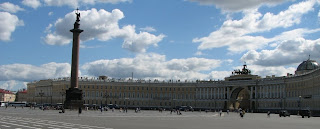 While it may sound like heresy, as St. Petersburg is one of the world's great cities, but Erik was initially underwhelmed by his foray into Russia's Venice. Of course, the city is important historically, architecturally, artistically, and politically, but an almost twenty year gap in visits can create unrealistic expectations. It was only on the second day, when he was able to view St. Petersburg through fresh eyes, that he appreciated its beauty and scale.
While it may sound like heresy, as St. Petersburg is one of the world's great cities, but Erik was initially underwhelmed by his foray into Russia's Venice. Of course, the city is important historically, architecturally, artistically, and politically, but an almost twenty year gap in visits can create unrealistic expectations. It was only on the second day, when he was able to view St. Petersburg through fresh eyes, that he appreciated its beauty and scale.
After fulfilling his workshop responsibilities, Erik had two days to see the sights. On the first day, he explored the city's major attractions: the Winter Palace, Hermitage, Bronze Horseman, and the major churches. He took the suburban commuter train (elektrichka) to the city, then navigated the metro to his destination.
Erik's trek down Nevskiy Prospekt began at the Kazan Cathedral (photo on the left). It is a massive church, with a great lateral wingspan, adorned with an eye of God in gold leaf.  As he entered the church, it became clear that a wedding was taking place. He stood in the wings and watched as the bride and groom (probably in their 30s) stood together as the choir chanted and relatives held crowns over their heads. He watched the service for a while, and surveyed the scene (as well as the long line to kiss an icon). He took no photos, as he never takes pictures during Divine Liturgy, even if the church generally allows photography.
As he entered the church, it became clear that a wedding was taking place. He stood in the wings and watched as the bride and groom (probably in their 30s) stood together as the choir chanted and relatives held crowns over their heads. He watched the service for a while, and surveyed the scene (as well as the long line to kiss an icon). He took no photos, as he never takes pictures during Divine Liturgy, even if the church generally allows photography.  As he continued his stroll along Nevskiy Prospekt, he eyed the lovely onion domes of Our Savior on Blood (photo on the right). Because it was several blocks off the main street, he planned to hit it on the way back to the metro. The next stop was the park that stretches by the Admiralty building to the square that abuts the Winter Palace and Hermitage on one end, and the Bronze Horseman on the other. Erik explored Palace Square, and investigated the possibility of seeing the Hermitage, but the line for entry was too long. He continued strolling through the park, and made his way to the Bronze Horseman, the iconic statue of the city.
As he continued his stroll along Nevskiy Prospekt, he eyed the lovely onion domes of Our Savior on Blood (photo on the right). Because it was several blocks off the main street, he planned to hit it on the way back to the metro. The next stop was the park that stretches by the Admiralty building to the square that abuts the Winter Palace and Hermitage on one end, and the Bronze Horseman on the other. Erik explored Palace Square, and investigated the possibility of seeing the Hermitage, but the line for entry was too long. He continued strolling through the park, and made his way to the Bronze Horseman, the iconic statue of the city.
While he was approaching the Horseman, another sight on the river caught his eye. Several military vessels - a guided missile cruiser, a destroyer, and other ships - were anchored along the river bank. 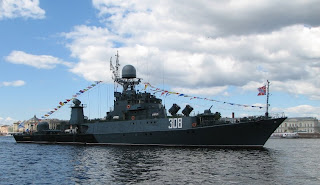 It turns out that Sunday was "Navy Day," the equivalent of New York's "Fleet Week" (presumably Russian sailors are more efficient than their American counterparts in their pursuit of drunken debauchery). After this detour, he swung by St. Isaac's Cathedral, and headed to Savior on Blood. The mosaics in Savior on Blood - covering every surface except the floor - were stunning. He wandered about, looking in every corner of the church, soaking up the colors and images.
It turns out that Sunday was "Navy Day," the equivalent of New York's "Fleet Week" (presumably Russian sailors are more efficient than their American counterparts in their pursuit of drunken debauchery). After this detour, he swung by St. Isaac's Cathedral, and headed to Savior on Blood. The mosaics in Savior on Blood - covering every surface except the floor - were stunning. He wandered about, looking in every corner of the church, soaking up the colors and images.
During his adventure, he also picked up some gifts for Lea and Carter. One of Carter's gifts is worth explaining. A couple of years ago, Erik found clothing produced by a Russian company with slogans in Russian. Carter's first shirt from this manufacturer featured a poem about fire engines, police cars, and taxis. He felt compelled to replace the outgrown shirt with another. While the selection was limited, he found a good one. The short-sleeved shirt honors the American invention of hacky sack. It says (in Russian): "A game in socks, thought up in the USA in 1972, socks, to another, footbag" It then says "footbag" in English, and "socks" in a kind of graffiti font. How can you go wrong with a mysterious Russian celebration of hacky sack - and socks?
On the second day in St. Petersburg, Erik was accompanied by another American presenter, Allan (who is on faculty at Michigan). 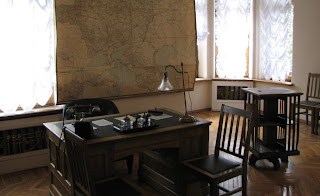 The first stop of the day was the Museum of Political History. It featured interesting Soviet-era political documents and material culture, including great election swag and photos from early Soviet elections. The most notable aspect of the building is that it housed the Bolsheviks' HQ. It was a great experience to stand in Lenin's office (photo on the left) and the rooms where the revolution was plotted! The revolutionary theme continued, with a walk by the cruiser Aurora. The Aurora fired the shot signaling the beginning of the October revolution.
The first stop of the day was the Museum of Political History. It featured interesting Soviet-era political documents and material culture, including great election swag and photos from early Soviet elections. The most notable aspect of the building is that it housed the Bolsheviks' HQ. It was a great experience to stand in Lenin's office (photo on the left) and the rooms where the revolution was plotted! The revolutionary theme continued, with a walk by the cruiser Aurora. The Aurora fired the shot signaling the beginning of the October revolution.
The next stop was the Peter and Paul Fortress. Built by Peter the Great, the island castle includes a church where Peter the Great is buried, several small museums (including, for some reason, a museum of the Soviet space industry), and a fantastic view of the river. Erik and Allan returned to Pushkin around 10 p.m., with the sun still shining. The next day, Erik packed his bags and headed home. More photos with captions are below.
The Bronze Horseman. 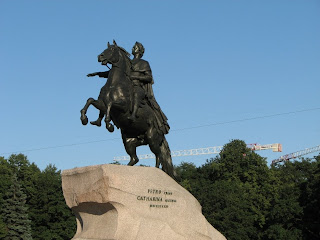 St. Isaac's Cathedral.
St. Isaac's Cathedral.  Erik on Palace Square.
Erik on Palace Square. 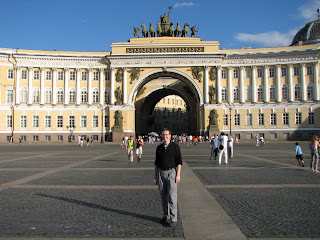 Church at Peter and Paul Fortress.
Church at Peter and Paul Fortress. 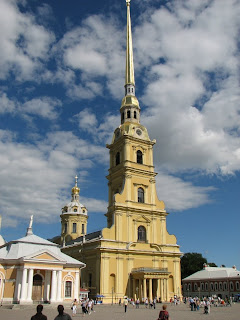
Savior on Blood.
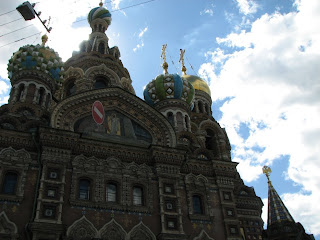
A few interior shots from Savior on Blood.
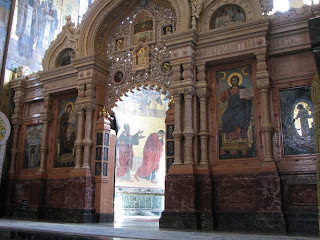
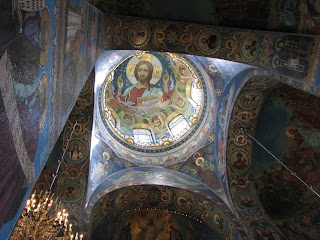
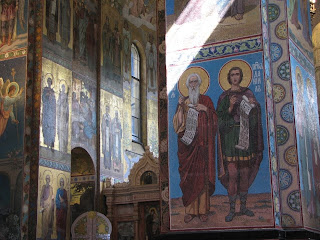 The Aurora.
The Aurora.
 A Bolshevik Party office.
A Bolshevik Party office. 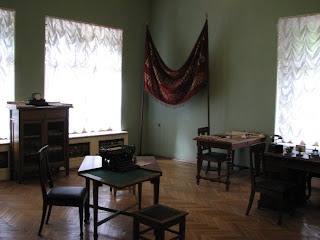 On the plane, Erik read a tale of cold war espionage. In honor of that book, below is a fake ham used to conceal revolutionary weapons.
On the plane, Erik read a tale of cold war espionage. In honor of that book, below is a fake ham used to conceal revolutionary weapons. 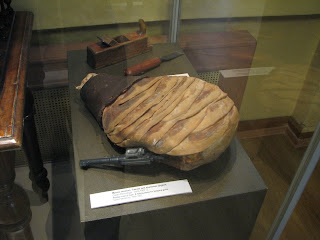 If nothing else, Russians have a positive body image. They seem willing to strip down at any opportunity to get some sun. Below you see sunbathers at the Peter and Paul Fortress. Erik also saw them on an artificial "beach" near brackish waters in Pushkin, and elsewhere. The most frightening sight? A middle-aged man in a lime-green thong (not pictured).
If nothing else, Russians have a positive body image. They seem willing to strip down at any opportunity to get some sun. Below you see sunbathers at the Peter and Paul Fortress. Erik also saw them on an artificial "beach" near brackish waters in Pushkin, and elsewhere. The most frightening sight? A middle-aged man in a lime-green thong (not pictured).  A final shot of St. Petersburg's lovely canals.
A final shot of St. Petersburg's lovely canals. 
 Early this year, a colleague at KU invited Erik to participate in a conference he was organizing in St. Petersburg, Russia. While Erik was intrigued, since he had not been to St. Petersburg since it was called Leningrad, work on the book and other complications made attendance at the spring conference impossible. However, when he received another invitation a few months later, he couldn't say no again. European University in St. Petersburg asked Erik to participate in a workshop designed to enhance the methodological training of faculty members in regional universities. His task was to talk about research methods in the study of comparative elections - right up his alley. Erik delivered three talks, and provided comments and consultations on participants' research projects.
Early this year, a colleague at KU invited Erik to participate in a conference he was organizing in St. Petersburg, Russia. While Erik was intrigued, since he had not been to St. Petersburg since it was called Leningrad, work on the book and other complications made attendance at the spring conference impossible. However, when he received another invitation a few months later, he couldn't say no again. European University in St. Petersburg asked Erik to participate in a workshop designed to enhance the methodological training of faculty members in regional universities. His task was to talk about research methods in the study of comparative elections - right up his alley. Erik delivered three talks, and provided comments and consultations on participants' research projects.
Erik's flights took him to St. Petersburg on LOT, Poland's airline. LOT is definitely a bargain carrier; it features few frills and minor mechanical problems abound. The meals underscored cost cutting measures. On his return trip, Erik ate the same meal of lunchmeat, cheese, and two small slices of bread THREE times! Economies of scale can be marvelous. On the way out, none of the seat controls worked in Erik's section. Although the cabin lights were dimmed for the movie, no one could hear it or turn on their reading lights. The benefit was that Erik slept a few hours on that leg of the journey. The trip on LOT requires two additional observations. First, timbersports athletes should avoid LOT if they are traveling to events in Eastern Euro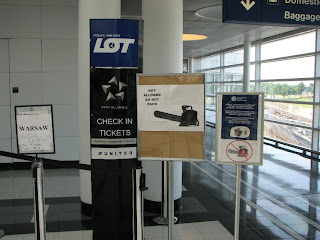 pe. Rather than posting a complete list of items that may not be carried on board flights, LOT specifically posted a large sign in English and Polish indicating that chainsaws are not allowed (photo on the left). Second, LOT seems to overbook its economy class on trans-Atlantic flights, then shuffles passengers by upgrading some and moving seatless refugees into the vacated spots (Erik was one of the seatless refugees on the way to St. Petersburg, but everything worked out).
pe. Rather than posting a complete list of items that may not be carried on board flights, LOT specifically posted a large sign in English and Polish indicating that chainsaws are not allowed (photo on the left). Second, LOT seems to overbook its economy class on trans-Atlantic flights, then shuffles passengers by upgrading some and moving seatless refugees into the vacated spots (Erik was one of the seatless refugees on the way to St. Petersburg, but everything worked out).
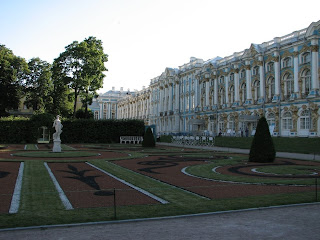 Because of the exorbitant costs in St. Petersburg proper, the workshop was held in a small town located nearby, Pushkin (also known as Tsarskoye Selo). The town is primarily famous because it houses Catherine the Great's "suburban" palace (see the photo on the left), lovely gardens, and other notable residences. The conference site was one of these famous homes - the Kochubey Manor. Kochubey Manor served as an estate for a nobleman (related to the Romanovs) and was built in the early 20th century. It has quite a bit of history: Sergey Kirov, whose assassination set off a series of purges under Stalin in the 1930s, stayed here for a while. It was also the local HQ for the Gestapo during Nazi occupation, but that part of the building was razed. The building is ornate, with contemporary artwork adorning the walls.
Because of the exorbitant costs in St. Petersburg proper, the workshop was held in a small town located nearby, Pushkin (also known as Tsarskoye Selo). The town is primarily famous because it houses Catherine the Great's "suburban" palace (see the photo on the left), lovely gardens, and other notable residences. The conference site was one of these famous homes - the Kochubey Manor. Kochubey Manor served as an estate for a nobleman (related to the Romanovs) and was built in the early 20th century. It has quite a bit of history: Sergey Kirov, whose assassination set off a series of purges under Stalin in the 1930s, stayed here for a while. It was also the local HQ for the Gestapo during Nazi occupation, but that part of the building was razed. The building is ornate, with contemporary artwork adorning the walls.
Given this history, it should be no surprise that the house has many ghosts. Fortunately, the part of the house where Erik stayed was spectre-free. But, the housing staff insists that ghosts haunt the old quarters. After dinner on Wednesday, Erik and a few other participants were treated to a tour of three rooms in the old part of the house. The first room was the white ballroom, which was plain but lovely. A quick anecdote about the ballroom: Kochubey wanted to enter the ballroom in a grand fashion, so arranged to have the ballroom doors open "automatically" with secret gears and ropes upon his arrival to formal events. Kochubey would give a secret signal (involving tapping some part of the floor) and a dedicated staff member would open his magical doors. The next room was the billiards room, which featured two huge tables, ornate woodwork, and a fireplace adorned with family symbols. Erik's favorite fireplace design was the bird that had pierced its own heart to feed baby birds its own blood.
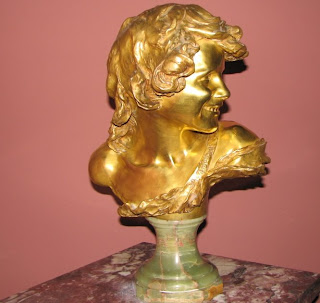
 In front of the third room, in a dark foyer, sat a lone bust of a boy. From one angle, the statue seems happy and benign, while from another he seems creepy. According to legend, visitors are supposed to leave money to avoid harassment and tricks. The third room was quite lovely, featuring many vases and statues, and an ornate piano that seemed to be made of birch wood. One of the busts was shrouded in an otherworldly way.
In front of the third room, in a dark foyer, sat a lone bust of a boy. From one angle, the statue seems happy and benign, while from another he seems creepy. According to legend, visitors are supposed to leave money to avoid harassment and tricks. The third room was quite lovely, featuring many vases and statues, and an ornate piano that seemed to be made of birch wood. One of the busts was shrouded in an otherworldly way.
After the tour, the manor's creepiness factor - and its appeal - increased. While Erik has seen his share of old estates, he is always ready to visit macabre, haunted manors! 